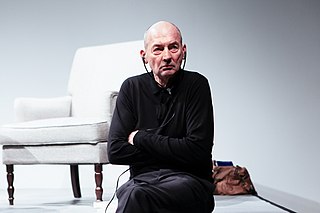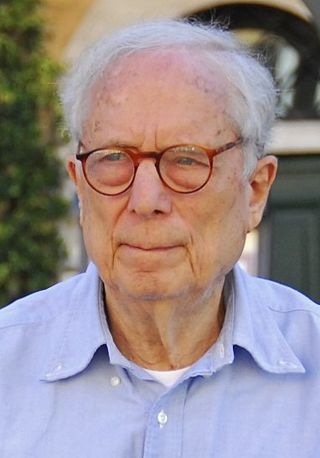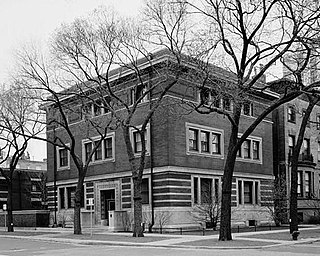
Remment Lucas Koolhaas is a Dutch architect, architectural theorist, urbanist and Professor in Practice of Architecture and Urban Design at the Graduate School of Design at Harvard University. He is often cited as a representative of Deconstructivism and is the author of Delirious New York: A Retroactive Manifesto for Manhattan.

Robert Charles Venturi Jr. was an American architect, founding principal of the firm Venturi, Scott Brown and Associates, and one of the major architectural figures of the 20th century.

The Office for Metropolitan Architecture (OMA) is an international architectural firm with offices in Rotterdam, New York, Hong Kong, Doha, and Australia. The firm is currently led by eight partners - Rem Koolhaas, Reinier de Graaf, Ellen van Loon, Shohei Shigematsu, Iyad Alsaka, Chris van Duijn, Jason Long, and managing partner and architect David Gianotten.

Mark Antony Wigley is a New Zealand-born architect and author based in the United States. From 2004 to 2014, he was the Dean of Columbia University's Graduate School of Architecture, Planning and Preservation.

Deconstructivism is a postmodern architectural movement which appeared in the 1980s. It gives the impression of the fragmentation of the constructed building, commonly characterised by an absence of obvious harmony, continuity, or symmetry. Its name is a portmanteau of Constructivism and "Deconstruction", a form of semiotic analysis developed by the French philosopher Jacques Derrida. Architects whose work is often described as deconstructivist include Zaha Hadid, Peter Eisenman, Frank Gehry, Rem Koolhaas, Daniel Libeskind, Bernard Tschumi, and Coop Himmelb(l)au.

Denise Scott Brown is an American architect, planner, writer, educator, and principal of the firm Venturi, Scott Brown and Associates in Philadelphia. Scott Brown and her husband and partner, Robert Venturi (1925-2018), are regarded as among the most influential architects of the twentieth century, both through their architecture and planning, and theoretical writing and teaching.

The Contemporary Arts Center (CAC) is a contemporary art museum in Cincinnati, Ohio and one of the first contemporary art institutions in the United States. The CAC is a non-collecting museum that focuses on new developments in painting, sculpture, photography, architecture, performance art and new media. Focusing on programming that reflects "the art of the last five minutes", the CAC has displayed the works of many now-famous artists early in their careers, including Andy Warhol. In 2003, the CAC moved to a new building designed by Zaha Hadid.

The Astor Street District is a historic district in Central Chicago, Illinois.

The Madlener House, also known as the Albert F. Madlener House, is a 20th-century mansion located in the Gold Coast neighborhood of Chicago, Illinois, USA. It is the work of architect Richard E. Schmidt (1865-1958) and designer Hugh M.G. Garden (1873-1961). Commissioned in 1901 and completed in 1902, the house was built as the residence for Albert Fridolin Madlener, a German-American brewery owner, and his wife, Elsa Seipp Madlener. Since 1963, it has been the headquarters of the Graham Foundation for Advanced Studies in the Fine Arts. In 1970, The Madlener House was placed on the National Register of Historic Places, and in 1973, it came under the protection of a Chicago ordinance protecting the city's historical and architectural landmarks. The house was fully remodeled and renovated by architect Daniel Brenner (1917-1977) in 1963–64.

The Netherlands Architecture Institute (NAI) was a cultural institute for architecture and urban development, which comprised a museum, an archive plus library and a platform for lectures and debates. The NAI was established in 1988 and was based in Rotterdam since 1993. It ceased to exist in 2013, when it became part of Het Nieuwe Instituut.

Cecil Balmond OBE is a Sri Lankan–British designer, artist, and writer. In 1968 Balmond joined Ove Arup & Partners, leading him to become deputy chairman. In 2000 he founded design and research group, the AGU.
The Berlage Institute was an independent unaccredited postgraduate school of architecture in Amsterdam and Rotterdam, Netherlands, that operated from 1990 to 2012. Named after the Dutch architect Hendrik Petrus Berlage, the Institute had an international student population and teaching staff.
The Pew Center for Arts & Heritage is a nonprofit grantmaking organization and knowledge-sharing hub for arts and culture in Philadelphia, Pennsylvania, US established in 2005. In 2008, Paula Marincola was named the first executive director. The Center receives funding from The Pew Charitable Trusts and makes project grants in two areas, Performance and Exhibitions & Public Interpretation, as well as awarding grants to individual artists through Pew Fellowships. In 2021, the Center announced the introduction of Re:imagining Recovery grants to assist in COVID-19 recovery.

Fondazione Prada, co-chaired by Miuccia Prada and Patrizio Bertelli since 1995, is an institution dedicated to contemporary art and culture. From 1993 to 2010, the Fondazione has organised 24 solo shows at its exhibition spaces in Milan, conceived as dialogues with acclaimed contemporary artists. In 2015, the Fondazione Prada opened a new, permanent facility in Milan.

The modern Qatari art movement emerged in the mid-20th century, as a result of the new-found wealth acquired from oil exports and subsequent modernization of Qatari society. Because of Islam's non-inclusive stance of depictions of sentient beings in visual arts, paintings historically played an insignificant role in the country's culture. Other visual art forms such as calligraphy, architecture and textiles were more highly regarded in the Bedouin tradition.
Senam Okudzeto is an American and British artist and educator who lives and works in Basel, London, Ghana and New York City.
Torkwase Dyson is an interdisciplinary artist based in Beacon, New York, United States. Dyson describes the themes of her work as "architecture, infrastructure, environmental justice, and abstract drawing." Her work is informed by her own theory of Black Compositional Thought. This working term considers how spatial networks—paths, throughways, water, architecture, and geographies—are composed by Black bodies as a means of exploring potential networks for Black liberation. She is represented by Pace Gallery and Richard Gray Gallery.

Delirious New York: A Retroactive Manifesto for Manhattan is a 1978 book, written by Dutch architect Rem Koolhaas. The book serves as a retroactive manifesto for Manhattan between 1850 and 1960, analyzing the development of architecture and urban design throughout New York's history from the founding of New Amsterdam by the Dutch, to the design of the Headquarters of the United Nations by Le Corbusier. Rem Koolhaas describes the concept of 'Manhattanism', the theory of the creation and functioning of the city of New York, at length in the book.
Meg Onli is an African-American art curator and writer. She is currently the Andrea B. Laporte Associate Curator at the Institute of Contemporary Art in Philadelphia, Pennsylvania. Her curatorial work primarily revolves around the black experience, language, and constructions of power and space. Her writing has been published in Art21, Daily Serving, and Art Papers. In September 2022, it was announced that Onli would co-curate the 2024 Whitney Biennial with Chrissie Iles.
Lydia Kallipoliti is a Greek architect, engineer, architectural historian, action researcher, and scholar. Her work examines interdisciplinary studies involving architecture, technology, and environmental politics.














